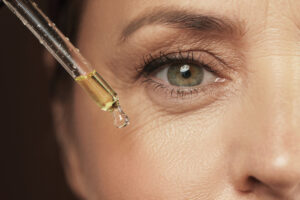Yes, you can lower your blood pressure without medication!
According to the American Heart Association, normal blood pressure should be somewhere below 120/80 mm Hg. Unfortunately, more than 100 million Americans—almost half of all US adults—suffer from hypertension! This is incredibly scary if you think about it, because high blood pressure is a leading factor in heart disease.
Most of these adults are on medication right now, but there are some 30 million who have stage 1 hypertension. Medication is not recommended for this condition, but if left untreated, it can lead to heart attacks, strokes, heart failure, and kidney disease.
Hopefully, there are many lifestyle changes that can lower your blood pressure, and we want to tell you more about them right now. Also, if you are on medication, never stop taking it without consulting your doctor first.

1. 8,200 steps a day!
What a specific number, right? You’ve probably heard before that if you want to be healthy, you need to take 10,000 steps per day, but a recent study from Vanderbilt University Medical Center in Nashville, Tennessee, shows that 8,200 might be the right number, and this is amazing news for us. So, get ready to lower your blood pressure without meds!
The study, which included almost 6,000 adults with an average age of 57, concluded with this result using both electronic health records and data from Fitbit devices.
But besides lowering blood pressure, this step count helps with maintaining a healthy weight. Participants who were categorized as overweight managed to lower their obesity risk by 64% just because they increased their daily step count to 11,000 steps.
If you think you are not able to take 8,200 steps, taking just 2,337 steps can also be beneficial because it still lowers your chances of dying from cardiovascular disease.
2. Try some wall sits
An analysis of 270 studies published in the British Journal of Sports Medicine (BJSM) in 2023 discovered that isometric workouts, particularly wall sits, prove helpful in decreasing blood pressure.
What is fascinating is that these studies found that exercises, where you keep your body in one position (planking or wall sits), are twice as effective at lowering blood pressure as biking, running, or other cardio-intensive activities.
If you think that this is something that suits you, just give it a try. It is a proven way to lower your blood pressure, so why not give it a chance? You can start with 20 or 30 seconds and then slowly increase the duration of the exercise. Also, before starting any new exercise routine, talk with your doctor. Try to have three sessions of such exercises every week.
3. Breathing muscle exercises are a game-changer
If you are looking for natural ways to lower your blood pressure, say no more! You can use your own breath for this, and there are studies that back up this affirmation.
Strengthening your breathing muscles can be incredibly useful when you are fighting hypertension, and we are about to explain how this works.
A 2022 study from the University of Colorado at Boulder found that high-intensity breathing exercises that are performed using a device that creates resistance while inhaling effectively lower blood pressure.
Participants in the study completed 30 resisted inhalations daily for six weeks, and the average decrease for the systolic pressure (the top number) was 9 mmHg and the one for the diastolic pressure (the bottom number) was 4 mmHg. What is so amazing about this finding is that this practice helps lower your blood pressure, and the results are comparable to the benefits you get from aerobic exercise, such as walking or jogging.
But hear us out, as the good news doesn’t stop here. Some doctors say that breath training can be as effective as some blood pressure medications. The key is to be consistent, and the results say that by doing so, you will successively lower your chances of cardiovascular disease by 25%.
So, how can you lower your blood pressure by doing breathing exercises? How is it working? It is all related to the production of nitric oxide. This molecule helps blood vessels relax and expand, and in the end, this means lower blood pressure. When you challenge your breathing muscles with high-resistance exercises, nitric oxide production will increase, leading to better vascular health.
4. Stretching might help
When you think about how to lower your blood pressure, you may imagine that you should engage in vigorous exercise routines. However, recent research suggests that there is a much easier way, and that is stretching. Yes, a study by the University of Saskatchewan in Canada discovered that stretching might be even more effective than walking when you want to reduce your blood pressure, and this is particularly true for those with hypertension.
The research was intended to see what the effects of walking are on older adults with hypertension, but things took an unexpected turn. The control group, which was just doing some regular stretching, exhibited lower blood pressure than the group that was walking.
But why is stretching so effective? It seems that stretching physically widens the blood vessels, and it also increases the elasticity of these vessels. In the end, arterial stiffness is reduced, and this is how you can lower your blood pressure just by stretching.
The scientists who led the study recommend focusing on major lower-body muscle groups such as the calves, hamstrings, and quadriceps.

5. Change your diet
One effective way to lower your blood pressure without medication is to be more careful about what you are eating and change your diet according to your condition.
The Dietary Approaches to Stop Hypertension (DASH) diet is the best diet for those suffering from hypertension and is also recognized by the American Heart Association. There are numerous studies that show the beneficial effects of this diet when trying to combat hypertension.
The DASH diet focuses on fruits, vegetables, lean protein, and low sodium intake, and it can prevent 26,000 heart-related events and nearly 3,000 deaths annually. But this diet is not only for those who already suffer from hypertension.
Linda Van Horn, PhD, MPS, is a study co-author, and she suggests that someone who follows this diet has a lower risk of developing increased blood pressure, which means it can prevent people from even reaching the higher risk categories, which is great if you ask us.
The DASH diet shares many similarities with the Mediterranean diet, and you should try to incorporate the following foods into your diet: lots of veggies, lean protein, fruits, grains, healthy fats, plant-based protein, and also limit your salt and sugar consumption as much as possible.
6. Tai chi
Are you looking for a more holistic approach to lowering your blood pressure? Tai chi might be perfect! This is an ancient Chinese practice that is known for its graceful movements and mindful breathing and that also lowers blood pressure, as recent studies show.
Practicing Tai Chi for just three months is an incredible way to start this journey, and you will be amazed by the results. Tai Chi promotes heart and cardiovascular health as the graceful and flowing motions increase your heart rate in a gentle manner, improving blood flow and circulation throughout your body.
If you want to get more tips about a healthy diet that can lower your blood pressure, this cookbook can be an amazing place to start: Heart Healthy Cookbook for Beginners: Transform Your Heart Health with 1500+ Days of Low-Sodium, Low-Fat Recipes
You should also read: Strengthening Your Core: 6 Easy Ab Exercises for Senior Wellness



















